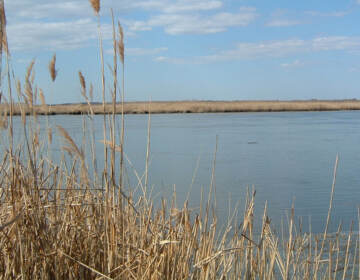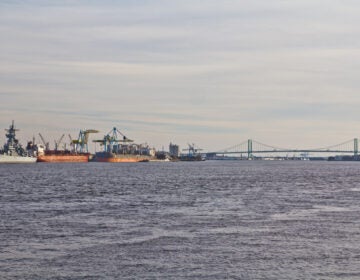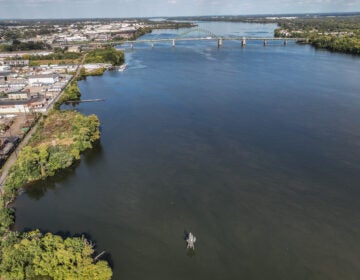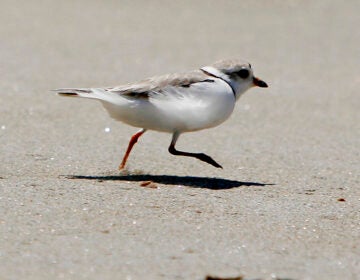Atlantic States Marine Fisheries Commission advances move to harvest female horseshoe crabs
The Atlantic States Marine Fisheries Commission has approved a new model for analyzing wildlife that would guide quotas beyond just male crabs.
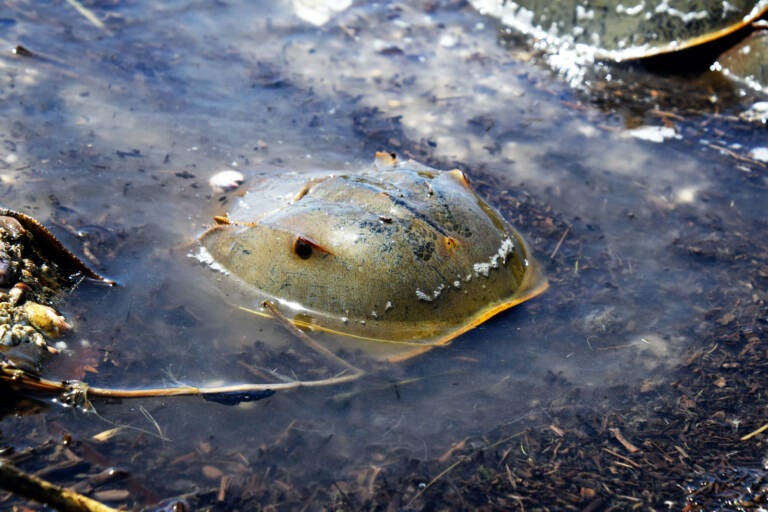
New Jersey has a moratorium on horseshoe crab harvesting, with an exemption for biomedical use. (Courtesy of Chris Neff/New Jersey Audubon)
A commission that coordinates the conservation and management of fish species on the Atlantic Coast has advanced a move that would allow for the harvesting of female horseshoe crabs along Delaware Bay.
The Atlantic States Marine Fisheries Commission has approved a new model for analyzing wildlife that will guide quotas for harvesting horseshoe crabs. Since 2012, the group’s method (known as the ARM Framework), used to optimize harvesting while balancing conservation, led to a male-only harvesting quota. But the revised method of analyzing species data would include females, which regional conservationists oppose.
As WHYY News reported before the commission’s Wednesday hearing on the matter, the conservationists argue that the harvesting of females would threaten the endangered red knot, shorebirds that rely on horseshoe crab eggs for sustenance on their spring stopover along Delaware Bay during the journey from South America to the Arctic, where they breed.
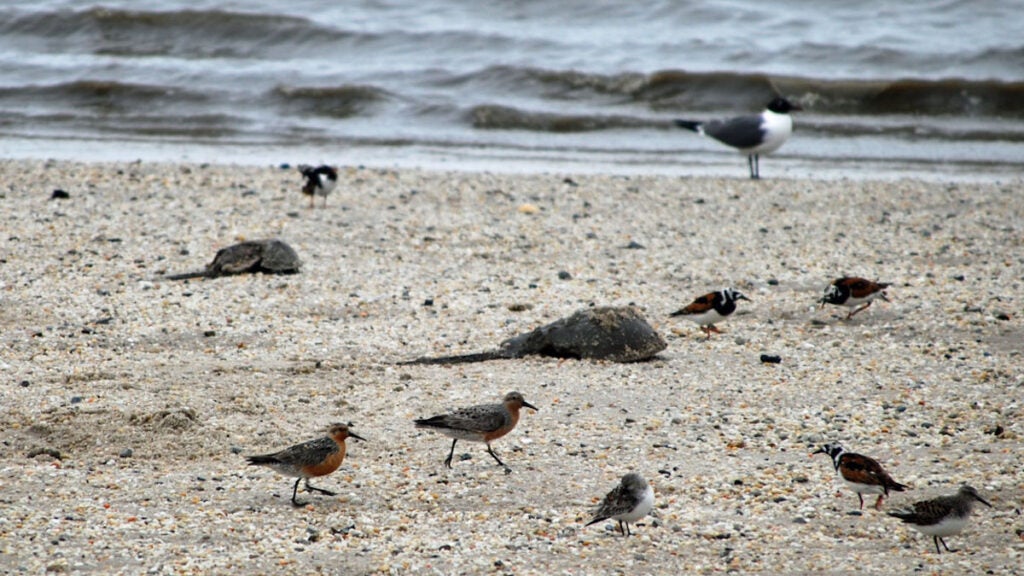
New Jersey has a moratorium on horseshoe crab harvesting, with an exemption for biomedical use, including research and the development of the COVID-19 vaccine. Delaware does not have a moratorium, though it bans harvesting for biomedical purposes, and the state follows the commission’s recommendations.
However, the commission must approve an addendum before a new harvesting quota will be enacted. Following outcry from some wildlife advocates, the panel decided to postpone that action to allow for public comment.
“We’re disappointed that the proposal is moving forward. Red knots are already facing serious threats, and this is not the time to take chances with their survival, which is what the proposal would do,” said Ben Levitan, an attorney at Earthjustice, a nonprofit public interest environmental law organization.
Levitan noted that “what [red knots] rely upon is the supply of horseshoe crab eggs that are waiting for them when they get [to the Delaware Bay]. They can quickly double their body weight and then successfully continue their journey to the Arctic Circle. Of course, that supply of horseshoe crab eggs depends on having enough female horseshoe crabs to lay them. So by resuming the harvest of female horseshoe crabs, that food supply is jeopardized.”
Joe Cimino, chair of the commission’s Horseshoe Crab Board, said in a statement on Thursday that the framework revision provides “a thorough picture of the population dynamics in the Delaware Bay Region.”
Cimino added that the board recognizes public concern about the impact to red knots, but that members are “committed to fully vetting its possible use in setting harvest levels for horseshoe crabs of Delaware Bay-origin through our public comment process.”
A U.S. Fish & Wildlife Service spokesman said the agency supports the new model. It is more accurate than the previous one, said the agency’s John Sweka, a fish biologist who also serves as biometrician of its regional fisheries program and is a chair of the commission’s ARM subcommittee.
The new model is based on empirical data collected directly from Delaware Bay, Sweka said, whereas the previous framework was based on scientific literature that may or may not have focused on the bay. For example, much information used to formulate the population model for horseshoe crabs was from Pleasant Bay, Mass., because Delaware Bay information wasn’t available.
For the first time, the framework will include data on additional sources of mortality, including horseshoe crabs that die after being bled and released for biomedical purposes and deaths caused by catch in other fisheries. That offers a better estimate of the number of crabs in the population, Sweka said.
A computer simulation based on their best knowledge of population growth in response to the harvest of horseshoe crabs shows that females can be harvested without having a negative impact on red knots, he said.
“This effort has a lot of very knowledgeable and experienced scientists working on it, and it has undergone a peer review by independent scientists representing expertise in fisheries management, shorebird ecology, horseshoe crab ecology, and adaptive management decision-making,” said Sweka, who helped develop the analytical modeling.
Under the previous framework, the Atlantic States Marine Fisheries Commission could select from five models based on the abundance of horseshoe crabs and red knots. Each year, the commission selected 500,000 males and zero females. But Sweka said if the species reached a certain population threshold, the quota for females would automatically jump from zero to 210,000 (the maximum allowed).
The maximum quota for females is the same in both models, but under the new one, quotas will increase gradually if female horseshoe crab abundance continues to increase, Sweka said. If the revised framework had been used in 2019, 144,803 females and 500,000 males would have been recommended, a base run of the model finds.
Levitan, of Earthjustice, argued that the fact that both models have the same maximum is irrelevant, because the commission has always selected a zero-female package due to the dire state of the species. Compounding this problem, Levitan argued, is that the new model would derive its horseshoe crab population estimates based “mostly on surveys that are not purpose-designed to count horseshoe crabs but that yield higher population estimates.” Therefore, he said, the horseshoe crab population estimates will be “inflated.”
Sweka said egg densities vary daily, hourly, and spatially along the beach, adding that eggs available to birds are determined by more than just the abundance of female horseshoe crabs — wind and wave action, and the slope of the beach play an important part.
“Since we have a direct link between the number of female horseshoe crabs and survival of red knots, we can skip the added uncertainty when attempting to include egg density data,” he said. “However, we do plan to continue to examine egg density data and the possibility of utilizing it more. This is one of many future research recommendations.”

Prior to Wednesday’s commission meeting, two of the 13 ARM subcommittee members issued minority opinions opposing the revision. One came from Wendy Walsh, a biologist with the Fish & Wildlife Service. She wrote that expert and stakeholder input suggest that horseshoe crab and red knot populations are too low to safely resume female harvest.
“There has been no change in the knot population, modest and uncertain growth in the crab population, and two highly aberrant stopover seasons in a row,” Walsh wrote. “Yet the ARM Subcommittee is now proposing, without the benefit of updated stakeholder input, to discard the previous utility function and to replace it with one that concludes female harvest can be safely resumed.”
The second opponent, Lawrence Niles of the Conserve Wildlife Foundation of New Jersey, told WHYY News in a Friday email that his stance was unchanged since Wednesday’s meeting.
“I feel the ARM Revision fails to accurately describe the circumstance of horseshoe crabs or red knots in Delaware Bay and the harvesting of female crabs will substantially impact egg densities and harm the red knots,” he wrote in the email.
“The ARM group refuses to incorporate egg density data in the model or even use it as a check on the model outcomes because it does not corroborate their assessment. Instead of seeing the model as faulty, they disparage egg data and add new horseshoe crabs surveys that substantiate their previously held opinion that the connection between red knots and horseshoe crabs is weak,” Niles continued. “This is against all evidence that the stopover has declined from over 90,000 red knots prior to the ASMFC’s sanctioned overharvest in the 1990s to only 6,800 last year. Egg densities have fallen from 50,000 eggs/square meter to just over 10,000 last year.”

Saturdays just got more interesting.
WHYY is your source for fact-based, in-depth journalism and information. As a nonprofit organization, we rely on financial support from readers like you. Please give today.




